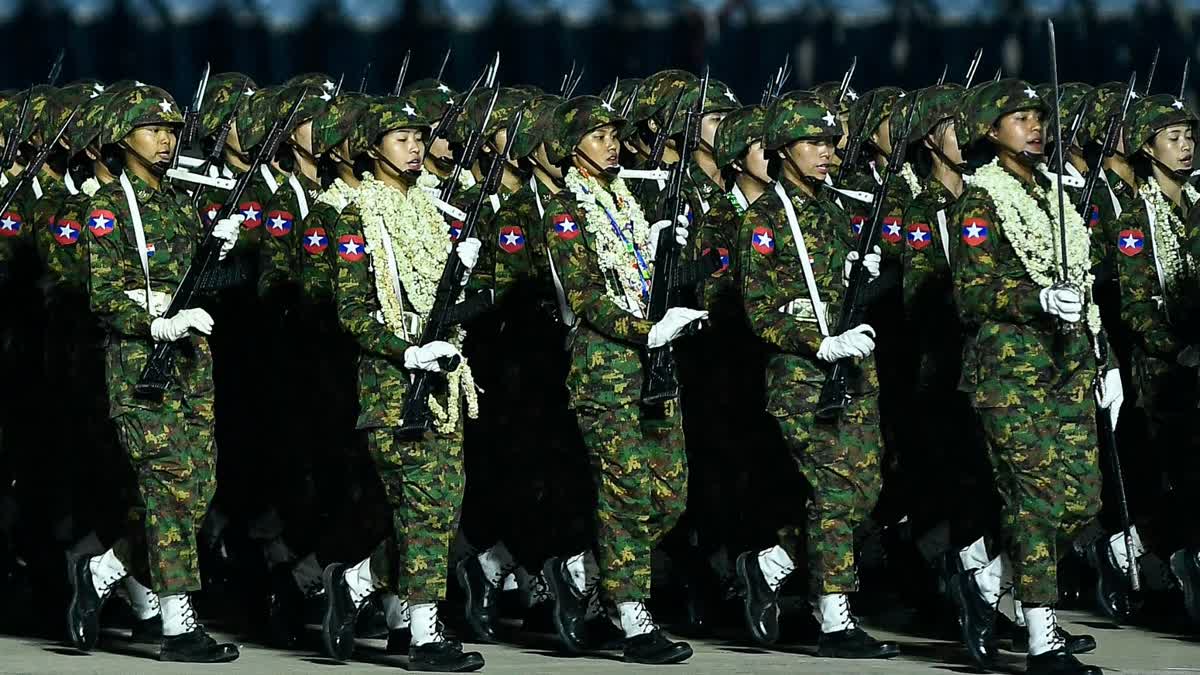New Delhi: In a significant development with potential implications for regional stability and India’s strategic interests, two key members of the Three Brotherhood Alliance - an armed coalition in Myanmar - have signaled willingness to engage in talks with the country’s military junta. This move comes amidst ongoing internal conflict and geopolitical shifts, positioning India to play a crucial role in navigating the balance between security concerns, regional connectivity, and its Act East Policy.
Last month, the ethnic Ta’ang National Liberation Army (TNLA) announced that it was ready to engage in peace talks with the Myanmar junta, expressing concern that civilians were bearing the brunt of armed conflict in northern Shan State.
“We are always ready to engage in dialogue to solve the problems, given the plight of war-affected civilians, while retaining our right to self-defence,” The Irrawaddy news portal cited the TNLA as saying in a statement.
Then again, last week, the Myanmar National Democratic Alliance Army (MNDAA) declared a unilateral ceasefire with the junta. The move comes after Chinese authorities placed MNDAA leader Peng Daren under house arrest in Kunming after his meeting there with China’s special envoy to Myanmar in late October. Beijing claims the MNDAA chief is in China for medical care, according to The Irrawaddy.
The third partner in the Brotherhood Alliance, the Arakan Army, however, has kept its offensive going and has claimed that it is now in full control of the country’s border with Bangladesh, after overcoming the final Myanmar military base in the town of Maungdaw.
Meanwhile, the Kachin Independence Army (KIA) another ethnic armed organisation, has also sent a delegation to China for talks with Beijing.
All these developments come amid hectic brokering by China to ensure an end to the conflict between the Myanmar junta and the ethnic armed organisations as Beijing is extremely concerned about the prospects about its Belt and Road Initiative (BRI) projects in Myanmar.
Myanmar serves as a gateway for China to the Indian Ocean, reducing Beijing’s dependence on the Strait of Malacca, a key chokepoint for global trade. By developing infrastructure in Myanmar, China can establish a direct overland trade route for its southwestern provinces, particularly Yunnan, facilitating greater economic integration and energy security.
The China-Myanmar Economic Corridor (CMEC) is a cornerstone of BRI cooperation in Myanmar. Spanning from China’s Yunnan province to Myanmar’s Rakhine State, the corridor is designed to enhance trade and investment. The corridor includes railways, highways, energy pipelines, and special economic zones (SEZs). Key areas under CMEC include Mandalay, Yangon, and Kyaukphyu. This corridor enhances regional connectivity and positions Myanmar as a vital logistics hub for China’s trade routes.
The Kyaukphyu deep-sea port is a critical part of the CMEC and serves as a gateway for oil and gas pipelines connecting Myanmar to Yunnan. It is expected to boost Myanmar’s trade capacity while providing China with direct access to the Indian Ocean. Critics, though, have raised alarms about potential debt dependency, as the project costs are significant relative to Myanmar’s GDP.
Twin pipelines, one for oil and one for natural gas, connect Kyaukphyu to Kunming in Yunnan, China. These pipelines enable the transport of energy resources from the Middle East and Africa directly to China, bypassing the Strait of Malacca.
Former Chinese President Hu Jintao described the Malacca Strait as the “Malacca Dilemma” as Beijing felt that the US or Indian navies would blockade or substantially interdict China’s Indian Ocean sea lines.
According to Srikanth Kondapalli, Professor of China Studies at Jawaharlal Nehru University in New Delhi, China is trying to create good neighbourly relations because its BRI projects in Myanmar are endangered by the civil war.
“China had to cancel the Myitsone Dam and the Letpadaung Copper Mine projects due to the civil war in Myanmar,” Kondapalli told ETV Bharat.
The Myitsone Dam is a large dam and hydroelectric power development project which was planned to be built in northern Myanmar. The proposed construction site is at the confluence of the Mali and N’mai rivers and the source of the Irrawaddy River. As of 2017, the project was suspended but China has been lobbying to revive the dam. The dam project has been controversial in Myanmar due to its enormous flooded area, environmental impacts, location 60 miles from the Sagaing faultline, and uneven share of electricity output between the two countries.
The Letpadaung Copper Mine is a large surface mine in the Salingyi Township of Sagaing Region of Myanmar. Since Myanmar began liberalising in 2011, the mine has been the site of contentious protest and come to symbolise the shortcomings of political reform. Villagers displaced by the Chinese-operated mine contend that they have not received fair compensation while the company claims that it has been socially responsible throughout the process.
Kondapalli said that China had billions of dollars in investments in these projects.
